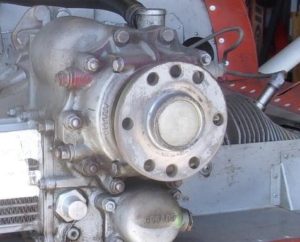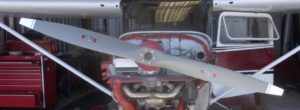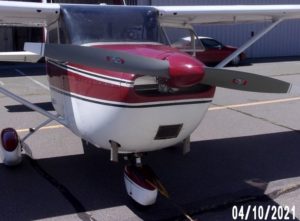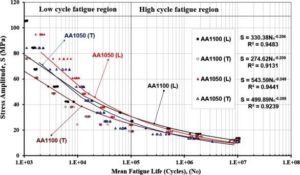All chapter members are invited and encouraged to take a few minutes and send us a photo and description of whatever project you are working on now or have recently completed. Send your text and photo(s) to eaa1541@gmail.com. Fun and education for everyone!
From Jim Hughes:
Aluminum Fixed Pitch Propellers don’t last forever.
I fly a 1961 Cessna 175B, which has a geared, GO-300 Continental engine, and drives an 84 inch fixed pitch propeller. Total time on the airframe is 4,020 hours. And since I couldn’t find any info on the prop being overhauled in either of the log books, I assumed that it has been 44 years since the prop was off the engine.
McCauley recommends an overhaul at 10 years or 1,500 hours, so we were way past the recommendation by 3x+.
During our annual in February, I convinced our co-owners that it was prudent and time to send the prop for overhaul.
The leading edges were bare metal and the tips had most of the black paint sand blasted off.
We struggled to remove the 6, ½ inch AN bolts and then pry the prop off the extended hub flange and the dowels that locate the prop on the flange . Here’s a pic of the flange, with a bit of corrosion from the spinner backing plate:

The 33 pound prop was now off and on it’s way to Stockton Propeller for overhaul, a simple – paint strip, pitch and tracking check and a new paint job.
After a week I got a call from Mike at Stockton Prop, that they had stripped the paint and had dye penetrant checked the blades and they looked ok. So the prop was off to pitch and tracking adjustment.
A few days later I go another call. In cleaning the hub area they noted something on the inside of the hub bore….it was a crack, verified with an eddy current test. A bit of grinding showed the crack getting larger. It was in-line with one of the bolt holes and the prop was now deemed un-airworthy, red tagged.
Our choice was to find a used replacement or buy a new prop from McCauley . A used prop would be ½ the cost of a new prop, so we ask them to see if were any available.
There were two used props available, one was a 63 pitch vs our 67 pitch and had been overhauled once.
The other was a 66 pitch and was full length and chord and was a better choice. It was in Alaska, so it was a week to ship it to Stockton. I was more than a little concerned with a prop from Alaska, with the harsh conditions there.
Once received, they proceeded to strip it and do both tests on it before doing anything else. It checked ok, so it was on to re-pitching to 67 inches and tracking adjustment.
 We had them paint it the original McCauley gray with white tips and add the 1960’s logo labels.
We had them paint it the original McCauley gray with white tips and add the 1960’s logo labels.
So, 2 months into the experience, we had a ‘new ‘ prop for ‘34T, and some ‘wall art’.
The prop bolts, nuts and washers are all standard AN hardware, and only $42 from A/C Spruce.
On Saturday, April 10th, our favorite A&P and two of us started the process of bolting the new prop to the flange.
No surprise, it didn’t just slip on! The dowels and raised hub are a bit of a press fit, which took tightening the 6 bolts and the metal lock nuts in a sequence to pull the prop onto the flange.
 Then it was three increasing torques to reach the 65 ft-lb on the 6 bolts.
Then it was three increasing torques to reach the 65 ft-lb on the 6 bolts.
The hard part was done. Now to add the spinner and the cowl halves.
After a few laps of the pattern to check the performance, 34T is back to airworthy condition.
But, in 10 years, the prop will be coming off for an overhaul check.

My recommendations to other pilots flying ‘classic’ aircraft with an aluminum, fixed pitch prop: it may look ok but may not be airworthy. Spending some $$ to have it overhauled as recommended may save an in-flight problem.
We were lucky, but we’ll be following the McCauley overhaul times with this prop.
Addendum: aluminum fatigue life in cycles vs. maximum stress.
Aluminum has a finite fatigue life. For propellers the fatigue cycles that dominate are the engine firing pulses. Being an engineer, I wanted to know if the propeller was close to failure, and was it predictable?
The max stress vs. fatigue life curve for aluminum typically goes out to 108 cycles i.e., 100 million. (See the chart below.) The GO-300 engine is run at 3,000 rpm, and with 3 pulses per revolution results in 2 x 109 cycles at 4000 hours, which is literally ‘off the chart’.

A Hartzel article that I found states that their propeller is designed for a stress of 4,700 psi.
Extrapolating to 109 cycles, it looks like it approaches the 4,700 psi limit.
So, based on this I could expect this prop to be close to failure at 4,000 hours.
I suspect that since this engine puts 400 ft-lb of torque into the prop because of the 3:4 ratio of the gearbox, and the prop has a higher inertia, being 84 inches in diameter, it can fail at a lower number of cycles than a 4 cylinder engine running at 2,200 rpm and putting 300 ft-lb into a 72 inch prop.
The question that comes to mind, is, if we had the prop overhauled as recommended at 10 years, would the prop still be airworthy?
